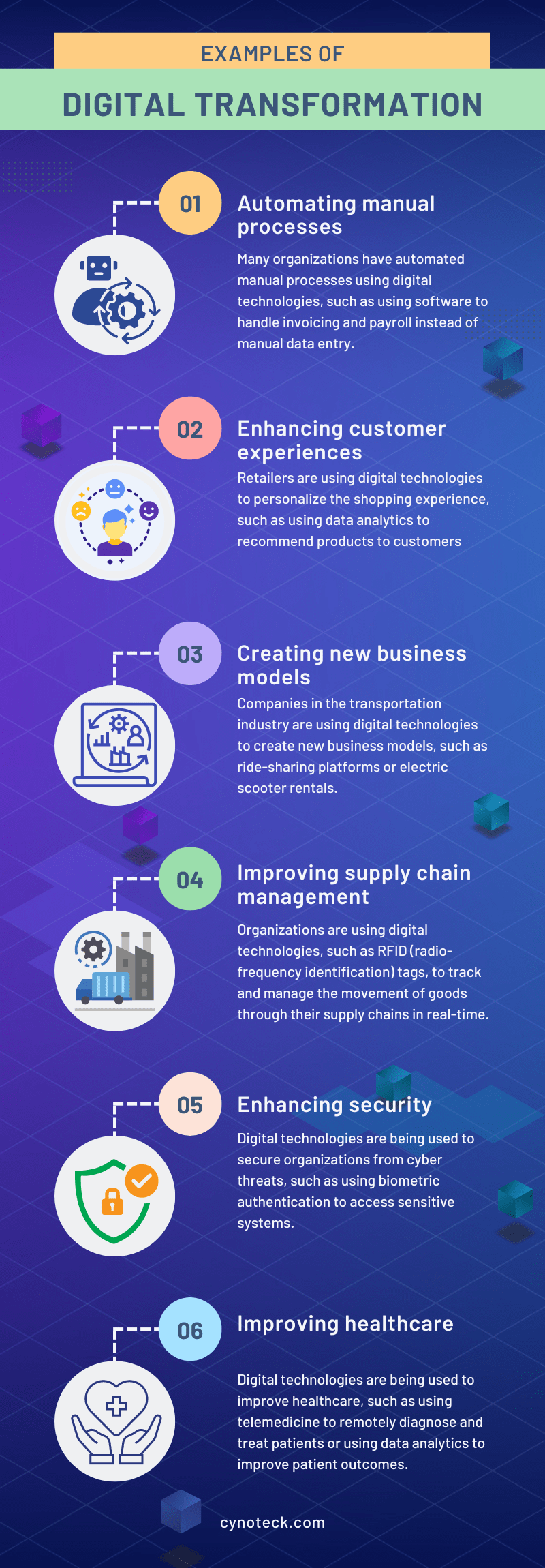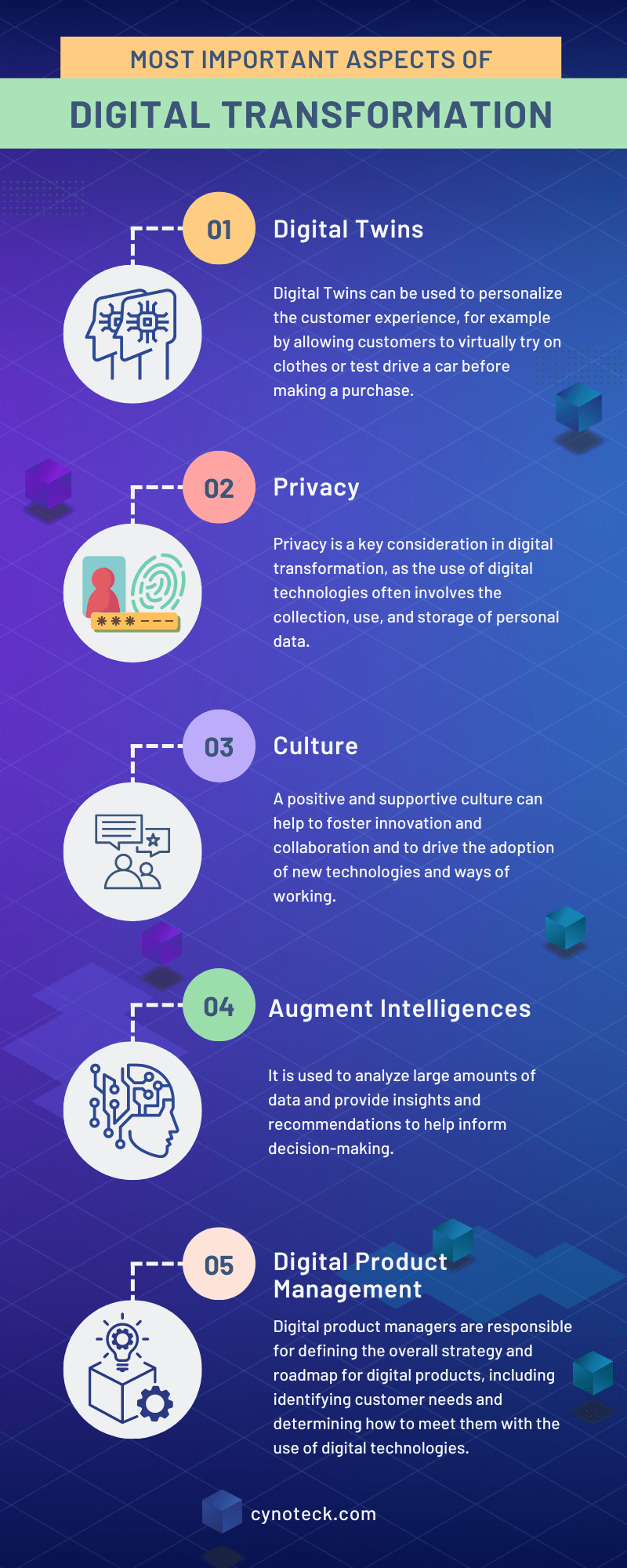As technology evolves, the goal of digital transformation is to help an organization become a digital enterprise, one that uses technology to continuously improve all facets of its business models. Not only it is important to incorporate new technological advancements in the digital sphere. But it is also essential to gain benefits through the right technique and strategy. Below, we’ve complied a detailed guide on how digital transformation can change your business dynamics.
What Is Digital Transformation?
Digital transformation is the process of revising and changing conventional and non-digital business processes and services or creating new ones using digital technology in order to meet changing customer and market expectations. This process significantly transforms how organizations are managed and how customers are provided with value.
We can broadly categorize enterprise digital transformation into three broad categories:
- Customer Experience– To provide the best quality experience to customers. Technology helps to consistently improve customer growth by identifying new trends and demands.
- Business Models – Changing the business by providing digital products, enhancing physical offers with digital tools and services, and employing technology to deliver shared services around the world.
- Operation Agility – Enhancing internal processes through the use of automation and digitization, providing workers with digital tools, and gathering data to track performance and make more informed business decisions.
Also, read: Digital Transformation in Healthcare: Key trends in healthcare for 2023
What Is the Importance of Digital Transformation?
Digital transformation is a mandatory need for businesses to thrive & survive. Almost every industry is now available for its consumers virtually. In research, it is found that people are opting for new behavioral trends.
The change has become more prevalent than ever since the beginning of the pandemic. As the demand spiked up and increased during the pandemic, technological advancements were needed more than ever.
Many companies are lagging behind for one reason – hesitance or avoidance. Some companies still don’t pay attention to the importance of digital transformation. And because of this, they are lagging to tap the online market or virtual platform to connect with customers.
Then there are a few who have been introduced into the digital zone but still aren’t well-equipped with the constant changes and new trends.
The most important part of digital transformation is to improve customer experience. Improving the overall customer experience is THE NEED for businesses to win over and grow.
Also, read: Vertical Experience in Digital Transformation: 5 Questions to Ask Your Contractor
How has the COVID-19 pandemic changed digital transformation?
In a huge way! To sum up, the whole approach has changed of digital technology since the pandemic. Firstly, the focus of the consumer’s changes to adapting to new technological trends.
Why? Because while the whole globe was shut down and people were at home, they kept looking for safe and feasible options. Whether it was about checking about any new updates or fulfilling requirements through online shopping. Any individual’s dependability switched to the digital domain.
Many firms have launched their business only on digital platforms and have successfully been able to grow exponentially.
In the technical domain, there have been many advancements to enhance the overall customer journey. Automation has been adopted to resolve queries and tasks.
Traditional manual labor was eliminated through automation. In the workforce also, employees went through a new notion of work through working remotely.
Also, read: How can a low code platform help in digital transformation
Why does Digital Transformation matter?
As the digital landscape continues to change and grow, digital transformation is becoming more and more vital for businesses of all kinds. Businesses that are slow to adopt new technologies risk being left behind by their competitors.
Digital transformation can help businesses to stay competitive by enabling them to take advantage of new technologies and better meet the needs of their customers.
It also helps businesses to streamline their operations and reduce the time it takes to deliver products and services to customers. This can lead to increased efficiency and productivity.
Digital transformation can also encourage a culture of continuous learning and innovation, as employees are exposed to new technologies and ways of working.
Don’t let your business fall behind.
Take the first step towards Digital Transformation and unleash the power of technology. Contact us today to learn more and schedule a consultation.
The Benefits of Digital Transformation
Digital technologies can help to automate manual processes, streamline operations, and reduce the need for manual data entry, freeing up time and resources for more valuable activities.
It can also be used to personalize the customer experience, making it more convenient and relevant.
This can help to build customer loyalty and increase customer satisfaction. By embracing digital transformation, organizations can differentiate themselves from their competitors and gain a competitive advantage.
Also, organizations can become more agile and better equipped to respond to changing market conditions and customer needs.
Digital transformation can enable organizations to create new products and services or to deliver existing ones in new and innovative ways.
This provides organizations with access to vast amounts of data, which can be used to inform decision-making and drive business strategy.
With digital innovations, organizations can help & secure their operations and protect sensitive data from cyber threats.
Also, read: Sales and Marketing Integration with Digital Automation
Examples of Digital Transformation
Every business domain is changing its module into the digital sphere. The need to be present in a digital platform is not enough. One needs to constantly manage and perform strategic plans to run a successful platform.
Following are a few examples of digital transformations:

Automating manual processes
Many organizations have automated manual processes using digital technologies, such as using software to handle invoicing and payroll instead of manual data entry.
Enhancing customer experiences
Retailers are using digital technologies to personalize the shopping experience, such as using data analytics to recommend products to customers or using augmented reality to help customers visualize products in their own homes.
Creating new business models
Companies in the transportation industry are using digital technologies to create new business models, such as ride-sharing platforms or electric scooter rentals.
Improving supply chain management
Organizations are using digital technologies, such as RFID (radio-frequency identification) tags, to track and manage the movement of goods through their supply chains in real-time.
Enhancing security
Digital technologies are being used to secure organizations from cyber threats, such as using biometric authentication to access sensitive systems.
Improving healthcare
Digital technologies are being used to improve healthcare, such as using telemedicine to remotely diagnose and treat patients or using data analytics to improve patient outcomes.
Also, read: What is Workflow Automation? And top Workflow Software for 2023
What role does culture play in digital transformation?
Culture plays a critical role in the success or failure of digital transformation initiatives. A positive and supportive culture can help to foster innovation and collaboration and to drive the adoption of new technologies and ways of working. Conversely, a negative or resistant culture can hinder digital transformation efforts.
A culture that encourages and supports innovation and risk-taking can help to foster the development and adoption of new technologies and ways of working.
It promotes collaboration and cross-functional teamwork and can help to facilitate the sharing of ideas and the development of new solutions.
An open culture willing to change & embrace new technologies and ways of working can be more conducive to digital transformation.
A culture that values and engages employees can help to drive the adoption of new technologies and ways of working, as employees are more likely to embrace change when they feel invested in the success of the organization.
Also, read: Salesforce Robotic Process Automation, AI Capabilities to Einstein Automate
Most Important Aspects of Digital Transformation
If you want to transform successfully keep any project’s progress heading toward your overarching corporate goals. In order to do this, it is necessary to persistently address the key factors driving digital transformation, including digital twin, privacy, culture, augmented intelligence, and digital product management.
There are major five broad arenas to reflect on for digital transformation:

1. Digital Twins
A digital twin is a virtual representation of a physical object or system, created using data from sensors and other sources. We can use them in a variety of contexts, including manufacturing, asset management, and building design.
To simulate and optimize processes, helping organizations to identify bottlenecks and inefficiencies, and make informed decisions about how to optimize their operations.
DT can be used to personalize the customer experience, for example by allowing customers to virtually try on clothes or test drive a car before making a purchase.
By using digital twins to simulate and test new ideas and processes, organizations can become more agile and better equipped to respond to changing market conditions and customer needs.
Through digital twins we can also optimize operations and enhance the customer experience, organizations can differentiate themselves from their competitors and gain a competitive advantage.
2. Privacy
Privacy is a key consideration in digital transformation, as the use of digital technologies often involves the collection, use, and storage of personal data. Ensuring the privacy and security of personal data is essential to building trust with customers and stakeholders, and complying with relevant laws and regulations.
This includes laws such as the General Data Protection Regulation (GDPR) in the European Union and the California Consumer Privacy Act (CCPA) in the United States, which establish specific requirements for the handling of personal data.
Privacy also includes establishing clear policies and procedures for the collection, use, and storage of personal data, as well as training employees on privacy best practices.
Privacy also includes encrypting data in transit and at rest, implementing access controls, and regularly testing and updating security systems.
It is important to note that organizations should be clear and transparent about their data collection and use practices and provide customers with information about their rights and options for controlling their data.
3. Culture
Culture plays a critical role in the success or failure of digital transformation initiatives. A positive and supportive culture can help to foster innovation and collaboration and to drive the adoption of new technologies and ways of working.
Conversely, a negative or resistant culture can hinder digital transformation efforts. A culture that encourages and supports innovation and risk-taking can help to foster the development and adoption of new technologies and ways of working.
It promotes collaboration and cross-functional teamwork and can help to facilitate the sharing of ideas and the development of new solutions.
Digital transformation may be facilitated better by a culture that is adaptable and eager to adopt new tools and methods of operation.
As workers are more likely to embrace change when they feel invested in the success of the company, a culture that values and engages employees can help to drive the adoption of new technology and ways of working.
4. Augment Intelligences
Augmented intelligence, also known as artificial intelligence (AI) augmentation, is the use of AI to enhance and augment human intelligence and capabilities, rather than replace them.
AI can be used to automate tasks and processes, freeing up human workers to focus on more valuable activities. It is used to analyze large amounts of data and provide insights and recommendations to help inform decision-making.
By using AI to automate routine tasks, organizations can become more agile and better equipped to respond to changing market conditions and customer needs.
AI can be used to personalize the customer experience, for example by using chatbots to answer customer inquiries or by using data analytics to recommend products or services.
5. Digital Product Management
Digital product management is the process of overseeing the development, launch, and ongoing management of digital products.
It is an important aspect of creating and delivering new products and services, or of enhancing existing ones using digital technologies.
Digital product managers are responsible for defining the overall strategy and roadmap for digital products, including identifying customer needs and determining how to meet them with the use of digital technologies.
Digital product managers work with cross-functional teams to gather and prioritize product requirements, ensuring that the product meets customer needs and aligns with business objectives.
It helps to oversee the development of digital products, including working with designers, developers, and other stakeholders to ensure that the product is delivered on time and to the required quality standards.
Digital product managers are responsible for launching and promoting digital products, including developing go-to-market strategies.
Also, read: Top 9 Software Development Models to Choose From: Phases and Applications
What are the key Trends in Tigital Transformation in 2023?
As technology advances, certain transformations see shifts and flows in popularity. Following trends is a terrific approach to learning how you may enhance your own digital transformations and get ready for your industry’s inevitable changes.
The use of cloud computing is likely to continue to grow, as it enables organizations to access computing resources on demand and scale up or down as needed.
The IoT, which refers to the growing network of connected devices that are able to collect and share data, is likely to continue to expand, enabling organizations to gather and analyze data from a wide range of sources.
As the digital landscape evolves, cybersecurity will continue to be an important area of focus, as organizations seek to protect against cyber threats and ensure the security of sensitive data.
As digital technologies continue to evolve, ethical considerations will become increasingly important, including issues such as data privacy, algorithmic bias, and the impact of technology on society.
Also, read: 7 Construction industry software solutions that have increased revenue for our clients
How can I measure ROI on Digital Transformation?
Measuring the return on investment (ROI) on digital transformation initiatives can be challenging, as it often involves quantifying the value of intangible benefits such as improved efficiency and customer satisfaction.
We suggest before you start your digital transformation initiative, it is important to establish clear goals and objectives, such as improving efficiency, enhancing customer experiences, or creating new revenue streams. This will help you to determine what success looks like and make it easier to measure the ROI.
Once you have established your goals and objectives, you can identify key performance indicators (KPIs) that will help you to measure progress and success. This might include metrics such as increased revenue, reduced costs, or improved customer satisfaction.
To evaluate the ROI of your digital transformation efforts, you will need to collect and analyze data on your KPIs. This might involve tracking metrics such as revenue, cost savings, or customer satisfaction levels.
Post-data analysis you can use to calculate the ROI of your digital transformation efforts. This might involve comparing the cost of the initiative to the benefits it has generated or using a more complex financial analysis to assess the long-term impact of the initiative.
Also, read: Automated Purchasing System for Business Growth: The 2022 Guide
Why Digital Transformation Projects Fail?
Without a clear understanding of what the project is trying to achieve, it is difficult to measure success and identify potential problems.
Digital transformation projects often require significant resources, including funding, personnel, and technology. Insufficient resources can hinder progress and increase the risk of failure.
Projects that are undergoing digital transformation often require changes to existing processes and ways of working, and it is important to ensure that all stakeholders are on board with these changes.
A Lack of buy-in from key stakeholders can hinder progress and increase the risk of failure.
Though these projects can be complex, involving the integration of multiple technologies and systems, and the coordination of multiple teams and stakeholders. This complexity can increase the risk of failure if it is not properly managed.
Digital transformation often requires changes to existing processes and ways of working, and it is important to manage this change effectively to ensure that it is successful. Failure to do so can result in resistance to change and hinder the project’s progress.
Don’t let your business fall behind.
Take the first step towards Digital Transformation and unleash the power of technology. Contact us today to learn more and schedule a consultation.
How to Get Started with Digital Transformation

1. Aligning goals and objectives together
Aligning digital transformation with business goals is essential for ensuring the success of the initiative. The first step is to clearly define the goals that the business is trying to achieve through digital transformation. This could include improving efficiency, increasing revenue, or enhancing customer experiences.
The next step is to identify the technologies and processes that will be most effective in supporting the business goals. This could involve using data analytics to gain insights into operations, automating tasks using artificial intelligence (AI), or improving customer communication using chatbots.
It is important to ensure that employees understand the goals of the digital transformation and how their work will contribute to achieving those goals. This can help to build buy-in and support for the initiative.
It is also important to establish metrics for measuring progress toward the business goals and regularly review the results to ensure that the digital transformation is on track.
2. IT and business must co-create
Technology and business goals are closely related, as technology is often used to support the achievement of business goals. It enables businesses to improve efficiency, reduce costs, and enhance customer experiences, all of which can contribute to the overall success of the organization.
To ensure that technology is used effectively to support business goals, it is important to align the technology strategy with the business strategy.
This involves identifying the technologies that will be most effective in supporting the business goals and implementing them in a way that is aligned with the overall direction of the organization.
It is also important to regularly review the progress of the technology implementation and assess its impact on the business goals. This can help to identify any issues or challenges that need to be addressed and ensure that the technology is being used effectively to support the business.
3. Always pick strategic partners
Choosing strategic partners is a crucial part of a digital transformation strategy, as partnerships can provide access to new technologies, expertise, and resources that can help the organization achieve its goals.
The first step is to clearly define the goals that the partnership is intended to achieve. This could include accessing new technologies, expanding into new markets, or gaining access to expertise in a particular area.
Following this comes to evaluate of potential partners based on their ability to help the organization achieve its goals. This could involve reviewing their track record, their technology offerings, and their alignment with the business’s values and culture.
Once a potential partner has been identified, it is important to negotiate the terms of the partnership to ensure that it is beneficial for both parties. This could include discussing revenue-sharing arrangements, intellectual property rights, and any other issues that can be relevant.
It is important to regularly review the partnership to ensure that it is meeting the goals that were set out at the outset and to identify any issues or challenges that need to be addressed.
4. Redesign business and products around customer outcomes
Redesigning businesses and products around customer outcomes are a key aspect of digital transformation. This involves using digital technologies and tools to better understand the needs and preferences of customers and to design products and services that are tailored to their needs.
Gather data about customer needs and preferences which involves using analytics tools to analyze customer behavior, conducting surveys or focus groups, or leveraging customer feedback from social media or online reviews.
The next phase involves determining the goods or services that may be enhanced to better satisfy consumer demands. This can entail enhancing the user experience, providing new features, or making the goods or services more practical or accessible.
Based on the insights gathered, now it’s time to redesign the products or services to better meet the needs of customers. This could involve creating new products or services, revising existing ones, or changing the way that they are delivered or accessed.
Once the products or services have been redesigned, it is important to test them with a small group of customers to gather feedback and make any necessary adjustments. This can help to ensure that the final products or services are well-suited to the needs of customers.
Making employees well-equipped with digital transformation
Retraining employees around digital transformation is an important aspect of ensuring the success of the initiative. The first step is to identify the skills that employees will need to succeed in their roles in the context of digital transformation.
This could involve assessing the current skills of the workforce and identifying any gaps that need to be addressed. Then comes the training plan that addresses the identified skills gaps. Providing employees with in-person training, online courses or other forms of learning are a few inclusions.
It is important to provide ongoing support to employees as they learn new skills and adapt to the changes brought about by digital transformation.
This could involve providing mentorship, coaching, or other forms of support. Encourage a culture of continuous learning within the organization to ensure that employees are able to adapt to new technologies and processes as they emerge.
Conclusion
Digital transformation is a complex and ongoing process, and it is important for organizations to carefully plan and manage their digital transformation efforts to ensure their success. This can involve setting clear goals and objectives, identifying key performance indicators, and collecting and analyzing data to measure progress and identify areas for improvement.
Also, read: Top 10 ERP software systems to implement in your production line
Frequently Asked Questions:
The term “digital transformation” describes the application of digital technology to fundamentally alter or develop new business procedures.
Investing in digital transformation initiatives might be expensive, but if done right, they can ultimately save a lot of money. Depending on the size of each initiative, the cost of each individual digital transformation project varies, however, it is anticipated that by 2023, enterprises would spend over $2.3 trillion on digital transformation projects.
Digital transformation can have both perks and pitfalls, it requires intense research planning and efforts. Few employees might hesitate to adapt to changes. And the outcomes are also not always assured. Also, the most important drawback can be the need for a huge investment.
Measuring the return on investment (ROI) of digital transformation initiatives can be challenging, as it often involves quantifying the value of intangible benefits such as improved efficiency and customer satisfaction. To measure the ROI of your digital transformation efforts, it is important to set clear goals and objectives, identify key performance indicators (KPIs), collect and analyze data, and use this data to calculate the ROI.
Some of the trends in digital transformation include the use of artificial intelligence and machine learning, the expansion of cloud computing, the growth of the Internet of Things (IoT), an increased focus on cybersecurity, and the importance of digital ethics. These and other trends are likely to continue to evolve as digital technologies continue to develop.

CRM Consulting services
Do you want to implement a CRM system within your organization? Connect with our CRM Experts today!



